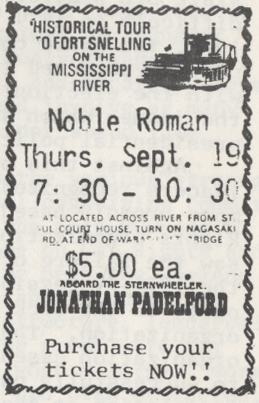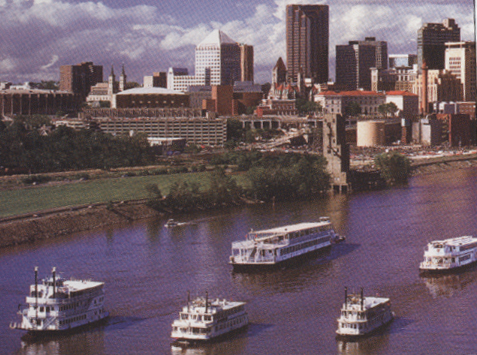Mississippi River
Shared by Minneapolis, St. Paul, St. Louis, Memphis, and New Orleans
| Advertisement for the first Riverboat Cruise on the Mississippi River from the Uptown Voice in 1974. Courtesy of the Jean-Nickolaus Tretter Collection. |
The fourth-longest river on Earth is bedrock for the history and culture of America’s heartland. The waterway is a divide where the established urban culture of America’s east meets the pioneer spirit of its dreaming west.
|
Minneapolis and St. Paul are uncommon settlements in this regard, as the two cities made use of unique geographic phenomena on the river; Minneapolis used the Mississippi’s only waterfall to power its grain mills before electricity, and St. Paul established itself as a trading center on the waterway’s northernmost steamboat landing.(5)
|
Eventually, advances in power and transportation technology made the river less significant to the nation’s economy. Cities were already sited, however—their placement created gravitational pulls that continued with or without their use of the Mississippi.
|
Poster Advertisement from the Paddleford Riverboat Copmany, c.1999. Courtesy of the Jean-Nickolaus Tretter Collection. |
A few Americans kept the Mississippi’s memory alive. In St. Paul, Captain William D. Bowell Sr. assembled a handful of riverboats beginning in 1969 (7)—the Twin Cities Pride committee became one of the captain’s early customers five years later. This began a tradition that continues to this day; stern-wheelers remain a popular Pride venue in 2009.(8)
(1) Mohl, Raymond A. The Making of Urban America. Maryland: SR Books, 1997. Page 346.
(2) Post, Dr. Robert C. "The History of Transportation Technologies," The Franklin Institute: http://www.fi.edu/learn/case-files/transportation.html. Retrieved 3/25/2010.
(3) Roland, Alex; Bolster, W. Jeffrey, and Keyssar, Alexander. The Way of the Ship: America's Maritime History Reenvisioned, 1600-2000 New york: John Wiley & Sons, 2008. Page 207.
(4) Wills, Jocelyn. Boosters, Hustlers, and Speculators: Entrepreneurial Cultures and the Rise of Minneapolis and St. Paul, 1849-1883. St. Paul: Minnsota Historical Society Press, 2005. All.
(5) Ibid.
(6) Kenney, Dave. Twin Cities Photo Album: a Visual History." St. Paul: Minnesota Historical Society Press, 2005. Page 255.
(7) http://www.riverrides.com/pages/misc/company.html
(8) http://www.tcpride.org/pride_events/2009_BoatCruise.php
Part of Minneapolis/St. Paul, MN: 100 Queer Places in Minnesota History, (1860-1969), (1969-2010)

